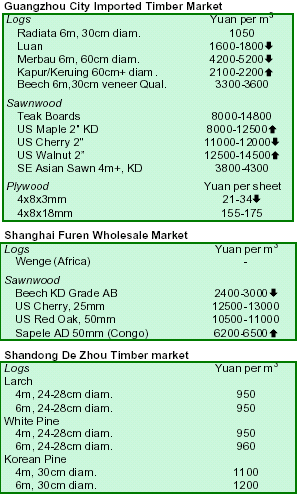|
China achieves first trade surplus in forest products
As the foreign trade of China¡¯s forest products developed rapidly in recent years, the country recorded its first trade
surplus in 2005. According to China Customs, the total value of foreign trade in national forest products was US$38.32 billion in 2005, up 18.5% from 2004. This accounted for 43% of the forestry industry¡¯s total output. Exports climbed 29.4% to over US$20 billion while
imports rose at a slower rate (7.9%) to $17.63 billion, thereby recording for the first time ever a trade surplus of
US$3.06 billion in 2005.
Local experts think that a continuous and rapid growth in foreign trade of forest products have not only enabled
Chinese products to become more competitive internationally but also helped upgrade forestry industry and promote the comprehensive development of the forest sector. Exports of forest products have become a major revenue source for some local governments, boosting farmers?income and creating jobs. Furthermo re, the increasing demand for raw materials has stimulated
the expansion of forest plantations.
Wooden furniture remains the top exported product and continuous to grow rapidly. It is followed by paper,
paperboard, wood products, plywood, and rattan, straw and reed products. The exports of plywood and fibreboard continued to expand but those of veneer and chipboard remained in decline. With regards to imports, log imports reached 29.37 million m3 ($3.24 billion) in 2005, up 12% in volume and 16%% in value. Sawnwood imports stood at 6.05 million m3, same as in 2004 but up 9% in value. The imports of wood-based panel (plywood, fiberboard and particle board) declined drastically. Wood pulp, waste paper, paper, paperboard and paper products remained the largest imported items at $11 billion, up 6.7% from 2004. The imports of edible fruits and nut products surged 3.7%.
China unveils forestry development goals
Jia Zhibang, Administrator of the State Forestry Administration, announced the development goals of China's forestry by 2010 in the national forestry meeting held in Beijing on 21 February 2006. China will strive to increase its forest cover to 20%, forest stocking volume to 13.2 billion m3 and the total forestry output value to 1.2 trillion yuan ($149.1 billion). About 110 million mu (1 hectare equals 15 mu) of sandy land will be contained. Half of natural wetlands and 90% of the country's key wildlife species will be protected. The total area of natural protected areas will be 1.88 billion mu and there
will be 2,800 forest parks. The output of commercial timber will reach 99.8 million m3 with about 70% of the timber coming from plantations. The utilization rate of timber will be raised to 70% and the stocking volume of forest stand per unit area will reach 93 m3 per hectare.
Hefty rise in furniture exports through Shenzhen
The value of furniture exports through Shenzhen Port rose 33.6% to $2.93 billion in 2005. Chinese furniture exports come predominantly from the Pearl River and Yangtze River Deltas, with Shenzhen Port accounting for 20% of the country’s furniture exports. Shenzhen's furniture exports went mainly to the USA ($1.2 billion, up 37% from 2004) and the EU ($420 million, up 55%). Wooden furniture accounted for half ($1.59 billion) of
the total Shenzhen furniture export value, up 50% from 2004.
New production base boosts Jiangsu as plywood hub
A large plywood production base is being built in Jiangsu Province at a total investment of $29.8 million. The plywood base consists of 17 hectares, 100,000 m2 of built areas and an expected annual production capacity of 800,000 m3. Around 98% of the output will be for the export market with sales expected at about $200 million per year. The base is expected to be completed by July 2007.
Boom time for plywood exports through Jiangsu
According to Jiangsu Customs, plywood exports through Jiangsu Port totaled 2.34 million m3 ($590 million) in 2005, up 38% in volume and 54% in value. The average plywood price was $253.7 per m3, up 11% from 2004. Local experts say that the boom is due to competitiveness of local firms and greater export volumes before the implementation of an export refund tax.


Birch- and poplar-poplar
ply have low yield rate due to small diameter and bad quality, and
are therefore more expensive than okoume-poplar ply.
|